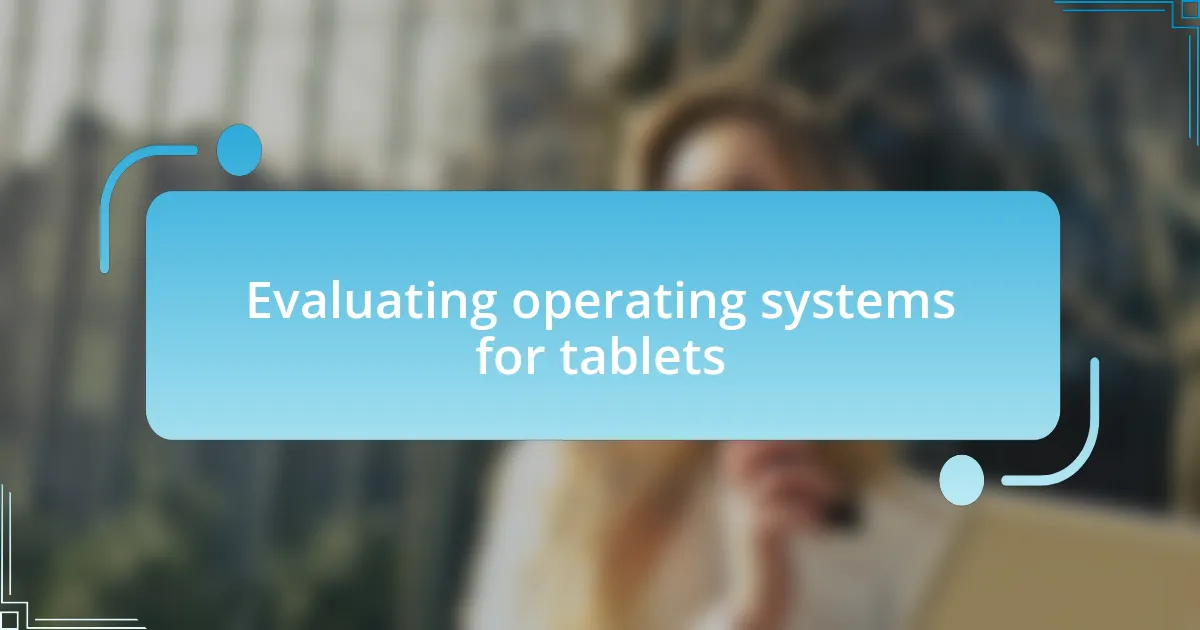Key takeaways:
- Identify your primary use case and prioritize portability when selecting a tablet.
- Evaluate the operating system based on app availability, user interface, and update support.
- Compare brands and models based on performance, customer reviews, and specific needs rather than brand loyalty.
- Consider your budget and additional costs, ensuring long-term usability over initial savings.

Understanding tablet selection process
Selecting the right tablet can feel overwhelming, especially with so many options available. I remember when I was in the market for one; I was practically drowning in specs, reviews, and prices. Have you ever felt that paradox of choice, where so many great options make it even harder to decide?
One crucial aspect of the selection process is identifying your primary use case. For instance, I need my tablet mainly for reading and taking notes during meetings. Understanding what you’ll mainly use your tablet for can significantly narrow down your choices and help you pick one that truly meets your needs. Considering the intended purpose invites a more focused evaluation, doesn’t it?
Another vital point to ponder is how important portability is for you. I once carried a bulky model around for weeks, only to realize it was more of a hindrance than a help. Does your lifestyle prioritize ease of transport and lightness? Assessing your routine can guide you toward a tablet that complements your daily activities.

Evaluating operating systems for tablets
Evaluating the operating system is often an overlooked but essential step in the tablet selection process. The operating system (OS) can significantly influence your tablet’s usability and compatibility with your favorite apps. I recall a time when I underestimated the impact of choosing between iOS and Android; what a difference that made in my daily tasks! The smooth experience of iOS compared to the flexibility of Android can make or break your preference, depending on how you plan to use your tablet.
Here are some key considerations when evaluating operating systems for tablets:
- App Availability: Different OS platforms offer varying app ecosystems. I often find myself leaning towards platforms with a broader app selection that meets my specific needs.
- User Interface: The ease of navigation can vary significantly. I remember switching to a device with a complex interface and wishing for the simplicity I had before.
- Updates and Support: Regular updates keep your device secure and running efficiently. It’s frustrating when a tablet manufacturers stop supporting older models.
- Customization Options: If you like personalizing your device, consider an OS that allows for more flexibility in customization.
- Device Integration: If you own other devices from the same brand, seamless integration can enhance your experience—something I’ve really appreciated over the years.

Comparing brands and models
When comparing brands and models for tablets, it can feel overwhelming due to the vast array of choices available. I’ve often found myself gravitating towards specific brands because of their reliability and reputation for quality. For instance, I’ve had consistently pleasant experiences with Apple tablets, particularly in terms of performance and build quality, while my experiences with other brands provided mixed results.
Diving deeper into specific models, I’ve learned that not all tablets, even within the same brand, are created equal. A friend of mine invested in a budget Android tablet only to find it lagged during everyday tasks. Meanwhile, I opted for a mid-range model and noticed a remarkable distinction in speed and battery life. These observations have taught me to prioritize my specific needs over just brand loyalty.
Lastly, it’s insightful to examine customer reviews and expert ratings side by side. Some models may shine in one area but falter in another. This nuance often slips by those shopping casually, but having my expectations set by thorough research has served me well. I remember consulting reviews before a purchase, which not only informed my decision but alleviated any buyer’s remorse later.
| Brand | Model | App Compatibility | Build Quality |
|---|---|---|---|
| Apple | iPad Air | Excellent | Premium |
| Samsung | Galaxy Tab S8 | Good | High |
| Amazon | Fire HD 10 | Limited | Decent |
| Microsoft | Surface Pro 7 | Excellent | Premium |

Assessing performance and storage options
When it comes to assessing performance, I always zoom in on the processor and RAM specifications. For example, I once chose a tablet with high RAM, thinking it would handle multitasking with ease. I was right; it zipped through apps effortlessly, which made my workflow smoother than I anticipated. Have you ever felt the frustration of lag? Investing in a powerful processor can truly make a world of difference.
Storage options are equally critical to consider. I remember wrestling with a tablet that had limited space, leading me to constantly delete files just to update apps. The stress was real! Nowadays, I assess storage capacity based on my content consumption habits; if you download a lot of movies or apps, a tablet with expandable storage might be essential for you too.
Don’t overlook the impact of software optimizations on performance. I was genuinely surprised by how much a simple software update improved my tablet’s speed. Some brands prioritize this aspect better than others. It’s worth investigating how each model handles updates to ensure your investment remains efficient over time. What’s your experience with software updates on your device? It can really be a game-changer!

Budget considerations for tablet buying
When it comes to budget considerations for buying a tablet, I often find myself torn between price and features. I remember my first tablet purchase, where I went for the cheapest option available, convinced I was getting a steal. However, I quickly realized that sacrificing a bit more money could have saved me from constant battery life complaints and a sluggish interface. How often do we prioritize savings without considering the long-term usability?
Setting a realistic budget is crucial; I always ask myself what I truly need versus what seems appealing. For instance, I once had my eye on a fancy model loaded with features I rarely used. After some thought, I recognized that a mid-range tablet met my daily needs just fine—streaming, basic word processing, and even some light gaming. It’s amazing how a little self-reflection can lead to better choices, isn’t it?
Don’t forget about additional costs, such as accessories or warranties. In my case, I initially overlooked the price of a protective case and screen protector. After a couple of accidental drops, those added expenses began to feel like smart investments. So, when budgeting for a tablet, consider all associated costs; they can either inflate the overall price or enhance your device’s lifespan significantly.
















